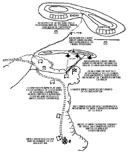
CHAPTER 8
ADMINISTRATION
| Paragraphs | ||
|---|---|---|
| SECTION I. | Supply | 194-203 |
| II. | Medical service and evacuation | 204-207 |
| III. | Motor maintenance | 208 |
SECTION I
SUPPLY
- REFERENCES.--For definitions, fundamentals, and methods relating to supply, see FM 100-10; for logistical data, see FM 7-55 and 101-10; for supply within the infantry regiment, see FM 7-30 and 7-40.
- RESPONSIBILITY.--Supply is a responsibility of command. This responsibility cannot be delegated. The company is the basic unit with administrative functions. The company commander is responsible for making timely requests for supplies and for distributing supplies received to the members of his company. He is also responsible for the supply of attached units or personnel.
- MEANS.--
- Personnel.--The administration group in
company headquarters consists of the following personnel,
whose duties and locations are as indicated:
- Mess sergeant, cooks, and cooks' helpers.--The mess sergeant is responsible for checking the rations and water issued the company, the division of rations into meals, the supervision of the cooks and cooks' helpers in the preparation of meals, and the distribution of meals to the company. Usually he and his assistants are in the regimental train bivouac, working under the direct supervision of the service company commander.
- Supply sergeant and armorer-artificer.--The supply sergeant is responsible for checking and distributing supplies, except rations and water. He keeps the company commander informed of the company needs. He also supervises the work of the armorer-artificer. During combat the supply sergeant will usually be in the forward area in order to assist the company
- Personnel.--The administration group in
company headquarters consists of the following personnel,
whose duties and locations are as indicated:
